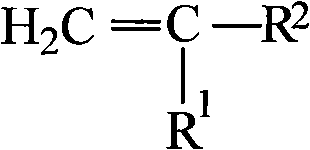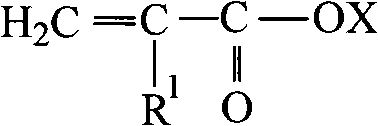Heat-storage and heat-preservation microcapsules and preparation method and application thereof
A technology of microcapsules and heat storage, applied in the direction of microcapsule preparation, microsphere preparation, chemical instruments and methods, etc., can solve the problems of difficult breakthroughs in wear resistance and durability of microcapsule shells, leakage of phase change materials, and overall performance of textiles Large changes and other problems, to achieve the effect of maintaining temperature control function, large phase change energy, wear resistance and durability
- Summary
- Abstract
- Description
- Claims
- Application Information
AI Technical Summary
Problems solved by technology
Method used
Image
Examples
Embodiment 1
[0035] At 40°C, 50 parts of No. 30 paraffin, 2 parts of Span 80, 3 parts of Tween 80, and 200 parts of distilled water were homogenized at high speed in a high-speed shear mixing emulsifier, and the homogenization rate was 10000 rpm. After 30 minutes, the Pour the homogenized emulsion into a three-necked flask, put it into a constant temperature water bath, and raise the temperature to 80°C under stirring conditions, and add 0.5 parts of ammonium persulfate and 20 parts of methyl acrylate to form the inner wall. After cooling, adjust the pH to 2-4 with acetic acid, add 80 parts of etherified melamine resin dropwise at a stirring speed of 300 rpm, raise the temperature to 55°C, keep it warm for 1-2 hours to cool the outer layer, and neutralize it with ammonia water to pH =7, to obtain heat storage and heat preservation microcapsule solution, and spray-dry to obtain No. 1 powdery heat storage and heat preservation microcapsules.
Embodiment 2
[0037] Heat storage and heat preservation finishing of pure knitted fabrics:
[0038] Process: padding method: padding (two dipping and two rolling, liquid carrying capacity 70%)→drying (90~100℃) for 2min
[0039] Padding solution prescription:
[0040] Thermal storage and thermal insulation microcapsule No. 1 50g / L
[0041] Formaldehyde-free super soft adhesive 30g / L
[0042] The color of the pure cotton before and after finishing is basically the same, and the hand feeling has little change. The formaldehyde content is 6.7mg / kg. After the knitted fabric is washed 20 times, the Cro value is only reduced by 0.3 after being tested by an incubator.
Embodiment 3
[0044] At 55°C, 10 parts of No. 52 paraffin, 40 parts of No. 30 paraffin, 6 parts of sodium lauryl sulfate, 804 parts of Tween, and 300 parts of distilled water were homogenized at high speed in a high-speed shear mixing emulsifier, and the homogenization rate was 10000rpm After 30 minutes, pour the homogenized emulsion into a three-necked flask, put it in a constant temperature water bath, and raise the temperature to 80°C under stirring conditions, add 0.5 parts of potassium persulfate and 22 parts of ethyl methacrylate to make the inner layer After the wall is cooled, adjust the pH to 3-4 with citric acid, add 80 parts of etherified melamine resin dropwise at a stirring speed of 300 rpm, raise the temperature to 55°C, and keep it warm for 1-2 hours to build the outer single-layer wall; After the system was cooled to room temperature, 80 parts of etherified melamine resin was added dropwise under agitation, the temperature was raised to 65°C, and the temperature was kept to c...
PUM
 Login to View More
Login to View More Abstract
Description
Claims
Application Information
 Login to View More
Login to View More - R&D
- Intellectual Property
- Life Sciences
- Materials
- Tech Scout
- Unparalleled Data Quality
- Higher Quality Content
- 60% Fewer Hallucinations
Browse by: Latest US Patents, China's latest patents, Technical Efficacy Thesaurus, Application Domain, Technology Topic, Popular Technical Reports.
© 2025 PatSnap. All rights reserved.Legal|Privacy policy|Modern Slavery Act Transparency Statement|Sitemap|About US| Contact US: help@patsnap.com



